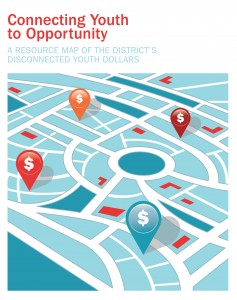 With the intent to outline the funding streams that sustain reconnection opportunities for DC youth, the DC Alliance of Youth Advocates (DCAYA), in partnership with The Community Foundation for the National Capital Region, releases “Connecting Youth to Opportunity: A Resource Map for the District’s Disconnected Youth Dollars.” The network of services navigated by disconnected youth is complex, with the District offering several programs and services across eight city agencies. The resource map is a tool for those seeking to utilize the District’s resources most effectively and to understand the complexities behind funding this unique, at-risk population. So what does this initial roadmap tell us about DC’s inventory of reconnection services? DCAYA has three key take-aways:
With the intent to outline the funding streams that sustain reconnection opportunities for DC youth, the DC Alliance of Youth Advocates (DCAYA), in partnership with The Community Foundation for the National Capital Region, releases “Connecting Youth to Opportunity: A Resource Map for the District’s Disconnected Youth Dollars.” The network of services navigated by disconnected youth is complex, with the District offering several programs and services across eight city agencies. The resource map is a tool for those seeking to utilize the District’s resources most effectively and to understand the complexities behind funding this unique, at-risk population. So what does this initial roadmap tell us about DC’s inventory of reconnection services? DCAYA has three key take-aways:
First, while cross agency coordination has improved to a degree, there still remains room for improvement. In order to capture the dynamic needs of youth and maximize investments in our public systems, agencies must collaborate to share services, expertise, and resources. One example, which is seen in the funding map, is the Pathways for Young Adults program. The Department of Employment Services (DOES) is partnering with the Community College of the District of Columbia (UDCC) to address the needs of disconnected youth by supplementing traditional occupational training with the chance to learn key life skills. Intentional partnerships between our workforce system and sister agencies is necessary if we are going to build a comprehensive and efficient workforce development system that youth can readily access and transition through as their needs evolve.
Second, the resource map also reveals a severe scarcity of year-round programming specific to disconnected young people. While $12,000,000 is spent on the six-week-long Summer Youth Employment Program (SYEP), less than $5,000,000 is slated for year-round workforce development training for out-of-school youth. Even though adult training programs are available for youth over 18, the rate at which youth access these programs is low, given their overrepresentation in our unemployment rate. Higher-need, less-skilled youth require modified programming that meets them where they’re at. We need to invest in year round training and job placement services that are designed to meet the unique needs of the disconnected youth population.
Third, and perhaps one of the most poignant pieces of the map, is the lack of local funding directed to youth who face the greatest risks of disconnection at key points of transition, like aging out of foster care, exiting the juvenile justice system, becoming young parents, or acclimating as first generation immigrations. We know these youth are especially vulnerable to disconnection and the resources and support they require are often a bit different and deeper than their peers. Yet, the District invests less than $1,500,000 in local dollars to these particularly high risk populations, while federal funds only account for $5,191,409 more.
In reviewing the resource roadmap and comparing various agency programs side-by-side, it is easy to see the startling reality of where the gaps and opportunities lie for disconnected youth. By understanding the various funding streams within our system of reconnection foundations, community advocates and policymakers can target future investments and strengthen our ability to intervene early and effectively. Join us in working with the Council to ensure that the 2015 budget includes strategic investments that connect youth to opportunities.
View “Connecting Youth to Opportunity: A Resource Map of the District’s Disconnected Youth Dollars.”
To print a copy of today’s blog, click here.
